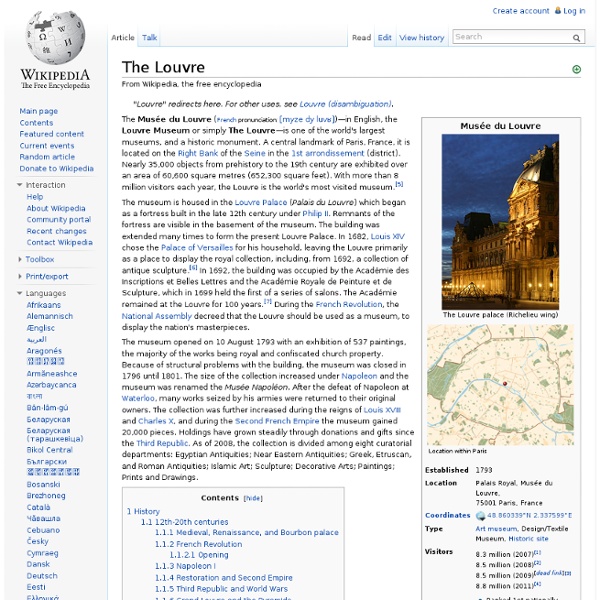Louvre
Création du département d'Antiquités égyptiennes La création d'un département d'antiquités égyptiennes au Louvre n'est pas la conséquence directe de l'expédition de Bonaparte en Égypte entre 1798 et 1801. Les antiquités recueillies alors par les savants furent saisies par les Anglais comme butin de guerre ; parmi elles, la célèbre Pierre de Rosette aujourd'hui à Londres. Un petit nombre d'œuvres rapportées à titre privé entrèrent au Louvre bien plus tard. En revanche, la publication du livre de souvenirs de Vivant Denon en 1802, Voyage dans la Haute et la Basse Égypte, et des volumes de la Description de l'Égypte, par les membres scientifiques de l'expédition, entre 1810 et 1830, réactive l'intérêt pour l'Égypte ancienne au cours du premier quart du 19e siècle, plus profondément que le goût superficiel qui s'était manifesté dans le mobilier à partir de la fin du règne de Louis XVI. Constitution de la collection Parti-pris muséographique
Wikipedia
The Museum of Fine Arts of Lyon ((French) Musée des beaux-arts de Lyon) is a municipal museum of fine arts in the French city of Lyon. It is housed near place des Terreaux in a former Benedictine convent of the 17th and 18th centuries. It was restored between 1988 and 1998, and despite these important restoration works it remained open to visitors. Its collections range from ancient Egypt antiquities to the Modern art period and make the museum one of the most important in Europe. It hosts important exhibitions of art : recently there have been exhibitions of works by Georges Braque and Henri Laurens (second half of 2005), then one on the work of Théodore Géricault (April to July 2006). Buildings[edit] Abbey[edit] Until 1792, the buildings belonged to the royal abbaye des Dames de Saint-Pierre, built in the 17th century. The Palais du commerce et des Arts[edit] The Musée des Beaux-Arts[edit] Collections[edit] Paintings[edit] Sculptures[edit] Antiquities[edit] Egypt[edit] Objets d’Art[edit]
Global Egyptian Museum
Mariemont
Wikipedia
The Egyptian Museum of Berlin (German: Ägyptisches Museum und Papyrussammlung) is home to one of the world's most important collections of Ancient Egyptian artifacts. The collection is part of the Neues Museum. History[edit] The museum originated in the 18th century from the royal art collection of the Prussian kings.[1] Alexander von Humboldt had recommended that an Egyptian section be created, and the first objects were brought to Berlin in 1828 under Friedrich Wilhelm III. After the Second World War, during which it was heavily damaged, the museum was divided between East and West Berlin, being reunited again after the Reunification of Germany.[1] Collection[edit] The most famous piece on display is the exceptionally well preserved and vividly coloured bust of Queen Nefertiti. See also[edit] Gallery[edit] Figure of a girl with a cat and standing figure of a young woman, 18th Dynasty, c. 1380 and 19. References[edit] ^ Jump up to: a b "Egyptian Museum and Papyrus Collection". Coordinates:
David Rumsey Historical Map Collection | The Collection
Antique Prints of Egypt
Beautiful Aquatints of Egypt Luigi Mayer, an Italian painter, created, among other travel descriptions, a wonderful series of drawings of pre-Napoleonic Egypt, commissioned by the British Ambassador to Constantinople (Istanbul), Robert Ainslie, at the turn to the 19th century. Mayer's drawings were supremely implemented as aquatint engravings by Thomas Milton and very handsomely hand colored. The various plates were dated between 1801 and 1803. Our series of aquatints are in very nice collectable conditon in superb hand coloring. Horizontal image size is approximately 22 x 31 cm (8.7 x 12.2") Vertical image size 31 x 22 cm (12.2 x 8.7") Page size 31 x 42.7 cm (12.2 x 16.8") Any larger deviations and in size and condition will be individually mentioned. Prices are noted with each print. "Joseph's Hall in the Castle of Cairo" Palaqce of en-Nasir Order Nr. “The Gate of Rosetta in Alexandra" Margins have been trimmed to sheet size of 29 x 37.3 cm (11.4 x 14.7") Nr. Order Nr. "Pompey's Pillar".
Universität Leipzig
Antikenmuseum der Universität LeipzigAlte NikolaischuleNikolaikirchhof 2 · 04109 Leipzig » Lageplan Informationen zur Alten Nikolaischule finden Sie auf der Homepage der Kulturstiftung Leipzig. Institut für Klassische Archäologieund Antikenmuseum der UniversitätRitterstraße 1404109 Leipzig Dienstag bis Donnerstag, Samstag und Sonntag 12 bis 17 UhrMontag und Freitag sowie an gesetzlichen Feiertagen geschlossen. Erwachsene: € 3,00Kinder bis 6 Jahre: freiErmäßigungsberechtigte (Schüler, Studenten, Auszubildende und Senioren gegen Vorlage entsprechender Ausweise): € 1,50LEIPZIG CARD und LEIPZIG Regio CARD: € 1,50 Freier Eintritt gegen Vorlage entsprechender Nachweise: Deutscher Archäologen Verband e.V. Citylage, wenige Gehminuten vom Hauptbahnhof entfernt. Innerstädtische Parkhäuser und Parkplätze Strassenbahnlinien der Leipziger Verkehrsbetriebe (LVB)Alle Linien mit Haltestelle am Hauptbahnhof oder Augustusplatz. Öffentliche Führungen nach Ankündigung in der Tagespresse (Museumseintritt.
Wikipedia
Roemer- und Pelizaeus-Museum The Roemer- und Pelizaeus-Museum Hildesheim is a museum in Hildesheim, Germany. Mostly dedicated to Ancient Egyptian and Ancient Peruvian art, the museum also includes the second largest collection of Chinese porcelain in Europe. In 2000, the old building, originally built in the 1950s, was replaced by a new building, significantly increasing the space available for exhibitions. The current museum is the result of the union of the Roemer Museum, founded in 1844 (and named after one of the founders, Herrmann Roemer), and the Pelizaeus Museum, established in 1911, that had housed the private collection of Egyptian antiques of Wilhelm Pelizaeus. Gallery[edit] External links[edit] Official website (English) Coordinates:
Roemer-Pelizaeus Hildesheim
The third part of the permanent exhibition focuses on some of the ancient Egypt antiquities, that can be seen as the most important source of knowledge about this culture: The belief in an afterlife. Organized into the areas “Man” and “Animal”, the exhibition picks up the two most important forms of burial, because in Egyptian belief the eternal accommodation of animals, which represent various Gods, is as important as that of men. Impressive examples show the architecture of private people’s tombes, among them the offering chapel from the Mastaba of Uhemka. Coffins, mummies, masks from different eras, amulets and shabtis represent the ideal burial equipment and illustrate the process of mummification.



